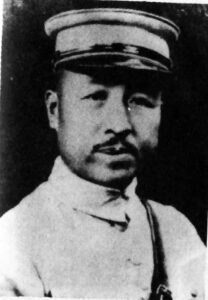Shang Chen (c. 1884-), military subordinate of Yen Hsi-shan who later served as governor of Hopei (1928-29), Shansi (1929-31), and Honan (1936). He headed the Chinese Military Mission to the United States in 1944-45. Little is known about Shang Chen's family background or early life except that he was born in Paoting, Chihli (Hopei) and that his native place was Shaohsing, Chekiang. After receiving a military education, he became a divisional staff officer in Fengtien, where he became active in the anti-Manchu revolutionary movement. With the establishment of the republic in 1912, he received command of a mixed brigade in Shantung. Later that year, he was transferred to an advisory post in the ministry of war. During the so-called second revolution of June-September 1913 he was arrested on suspicion of complicity in the anti- Yuan plot, but he was released soon afterwards and was given a post in Mienchih, Honan. In 1914 he received command of a regiment in the forces of Feng Yu-hsiang's uncle Lu Chien-chang. He spent 1914 and 1915 campaigning against bandits in northern Shensi. In 1916 Shang Chen led his regiment into Shansi and entered the service of Yen Hsi-shan (q.v.). He soon rose in rank and power from commander of the Shansi 1st Mixed Brigade to commander of the Shansi Temporary 1st Division, director of the Taiyuan arsenal, and defense commander for southern Shensi. In September 1926 Yen Hsi-shan appointed Shang military governor of the Suiyuan special district. When Yen decided to support the Northern Expedition, Shang received command of the First Army of the Northern Route of the National Revolutionary Army. When Yen's forces were reorganized in 1927 as the Third Army Group, Shang became field commander of that army's northern route. He served as field commander of the entire Third Army Group during the final stage of the Northern Expedition in 1928, and his own First Army led the way into Paoting and Peking. At the end of June 1928 Shang Chen was rewarded for his services during the Northern Expedition with appointments as governor of Hopei, bandit-suppression commander in Hopei, and deputy (under Yen Hsi-shan) Peiping-Tientsin garrison commander. Soon afterwards, he became a member of the Peiping branch of the Political Council. When Yen Hsi-shan became minister of interior in the new National Government established at Nanking in October 1928, Shang assumed full command of the Peiping-Tientsin garrison forces. In 1929 Shang was appointed governor of Shansi in September and was elected an alternate member of the Kuomintang's Central Supervisory Committee at year's end. About this time, he apparently decided that his future prospects would be enhanced if he dissociated himself from Yen Hsi-shan. Thus, he did not take part in the activities of the so-called northern coalition {see Yen Hsi-shan; Feng Yu-hsiang) in 1930.
Shang Chen received command of the Fourth Army in 1930 and of the Thirty-second Army in 1931. He was succeeded as governor of Shansi by Hsu Yung-ch'ang (q.v.) in August 1931, at which time he received command of the Third Army Group of the so-called northern bandit-suppression forces. Early in 1933 he was appointed commander in chief of the Second Army Group in north China and was dispatched to the Great Wall, where his forces performed well in turning back the Japanese at Langkow. Beginning in June 1934, Shang served as adjutant of the Lushan Officers Training Corps. He was reassigned to north China in June 1935 as Tangku-Paoan commander and mayor of Tientsin. After the Ho-Umezu agreement {see Ho Ying-ch'in), he was appointed governor of Hopei and was elevated to full membership on the Central Supervisory Committee of the Kuomintang. He was transferred to the governorship of Honan in January 1936, but later that year he left that post to assume command of the Twentieth Army Group in north China. In 1939, the second year of the Sino- Japanese war, Shang Chen became deputy commander of the Ninth War Area. He was appointed commander of the Sixth War Area and director of the executive office of the Military Affairs Commission in 1940 and was given the additional post of director of the commission's foreign affairs bureau in 1941. He held these posts until 1944, when he was made chief of the Chinese Military Mission to the United States. The mission's chief function was to obtain supplies of war materiel, and Shang was chosen to head it because of his military knowledge, command of English, and prowess at polo. In 1946 he also served as chief Chinese delegate to the Military Staff Commission of the United Nations. Ho Ying-ch'in succeeded him in these posts in October 1946, and Shang then returned to China to become chief adjutant to Chiang Kai-shek.
Shang Chen went to Japan in April 1947 as Chinese delegate to the Allied Council and head of the Chinese mission in Japan. With the Chinese Communist victory on the mainland and the withdrawal of the National Government to Taiwan in 1949, Shang left public life to embark upon a comfortable retirement in Japan.

商震
字:启予
商震(1884—),阎锡山部下,1928—29年、1929—31年、1936年先后任河北、山西、河南省主席。1944—45年率领军事代表团去美国。
商震的家庭情况和早年生活不详,他出生在河北保定,祖籍浙江绍兴。早年受军事教育后,在奉天任师参谋官,从事反满革命活动。1912年民国成立后,在山东任第二混成旅旅长,同年年底,调任陆军部顾问。1913年6月到9月间二次革命时,因有反袁嫌疑被捕,不久释放,在河南渑池任职。1914年,在冯玉祥姑丈陆建章手下任团长,1914至1915年在陕北剿匪。
1916年,商震带领他的一团军队到山西投奔阎锡山,不久他从山西第一混成旅长升为山西暂编第一师师长,太原兵工厂督办,晋南镇守使。1926年9月,阎锡山任命商震为绥远特区都统。阎锡山决定支持北伐时,商震任国民革命军北路军第一军军长。1927年,阎锡山的部队改编为第三集团军,商震任该集团军北路前敌总指挥。1928年在北伐最后阶段,商震任第三集团军前敌总指挥,其所率的第一军首先进据保定和北京。
1928年6月底,商震因参加北伐有功,被任命为河北省主席、河北剿匪司令、平津警备副司令(司令阎锡山)。不久,又成为北平政治分会委员。1928年10月阎锡山任国民政府内政部长时,商已握有指挥平津警备部队的全权。1929年10月,任山西省主席,同年底任国民党中央监察委员会候补委员。当时,他已认定,为了发展个人前途必须与阎锡山脱离关系,因此未参加1930年的阎冯北方联盟。
1930年,商震任第四军军长,1931年任第三十二军军长。1931年8月,徐永昌继他任山西省主席,他改任第三集团军北路剿匪司令。1933年初,任华北第二军团司令,在长城冷口击败日军。1934年6月初,任庐山军官训练团副官长。1935年回华北任塘沽警备司令、天津市长。何梅协定签订后,任河北省主席,升任中央监察委员。1936年1月,调任河南省主席,年底调任在华北的第二十军团司令。
1939年,商震任第九战区副司令,1940年任第六战区司令,军事委员会执行部主任,1941年兼任外事部主任。1944年,他担任军事代表团团长去美国,任务是去获取战争物资的供应。挑选商为团长是鉴于他的军事知识,熟谙英语和打马球的技能。1946年商任联合国军事参谋处中国首席代表。1946年10月,何应钦接替他的这些职务。商回国任蒋介石的副官长。
1947年4月,商震去日本任盟国管制委员会中国代表兼驻日使团团长。1949年共产党占领大陆,国民政府迁往台湾,商震退出政界生活,在日本过着舒适的退休生活。